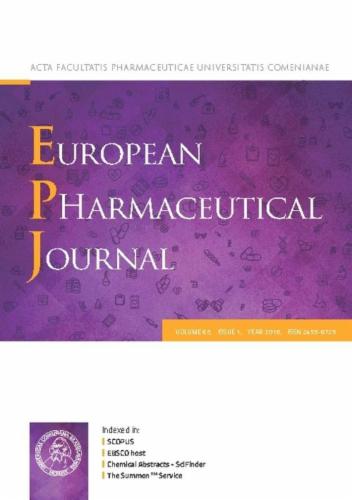硒sammaplin A类似物(SPA-10091-HCl)通过组蛋白甲基转移酶DOT1L降解和诱导凋亡在去势抵抗前列腺癌细胞中的抗肿瘤活性
IF 4.3
3区 医学
Q1 PHARMACOLOGY & PHARMACY
引用次数: 0
摘要
去势抵抗性前列腺癌(CRPC)是男性最困难的癌症之一,其特点是预后差,转移风险高。端粒沉默1样干扰物(DOT1L)的过表达与CRPC患者的不良预后有关,DOT1L是组蛋白H3在赖氨酸残基79 (H3K79)上的特异性甲基转移酶。因此,靶向DOT1L被认为是克服CRPC重大医学挑战的潜在治疗方法。在我们之前的研究中,我们设计了selenopsammaplin A (SPA)类似物作为非核苷类DOT1L抑制剂来抑制人乳腺癌细胞的增殖和转移。然而,SPA类似物在PC细胞中的抗肿瘤活性和确切的潜在机制尚不清楚。在本研究中,我们给药SPA-10091-HCl,一种dot1l靶向降解剂,可以有效地抑制CRPC (PC3和DU145)细胞的生长和dot1l介导的H3K79甲基化。在机制上,SPA-10091-HCl通过核泛素-蛋白酶体途径选择性降解DOT1L蛋白,从而抑制CRPC细胞中的H3K79甲基化。SPA-10091-HCl抑制CRPC细胞的增殖、迁移和侵袭,表达上调E-cadherin,下调N-cadherin和vimentin表达。此外,长时间的SPA-10091-HCl处理通过调节凋亡相关蛋白的表达诱导凋亡,包括聚(adp -核糖)聚合酶(PARP)、caspase-3、caspase-9和Bcl-2。此外,SPA-10091-HCl可有效抑制PC3细胞移植小鼠模型的肿瘤生长,且无明显毒性。这些结果表明,SPA-10091-HCl作为抗CRPC的化疗药物有进一步开发的潜力。本文章由计算机程序翻译,如有差异,请以英文原文为准。

Antitumor activity of selenopsammaplin A analog (SPA-10091-HCl) via histone methyltransferase DOT1L degradation and apoptosis induction in castration-resistant prostate cancer cells
Castrate-resistant prostate cancer (CRPC) is one of the most difficult cancers in men and is characterized by a poor prognosis and a high risk of metastasis. The overexpression of the disruptor of telomeric silencing 1-like (DOT1L), which is a specific methyltransferase for histone H3 at lysine residue 79 (H3K79), has been related to poor outcomes in patients with CRPC. Therefore, targeting DOT1L is considered a potential therapeutic approach to overcome the significant medical challenges of CRPC. In our previous study, we designed selenopsammaplin A (SPA) analogs as non-nucleoside DOT1L inhibitors to suppress human breast cancer cell proliferation and metastasis. However, the antitumor activity and the precise underlying mechanism of SPA analogs in PC cells remain unclear. Herein, we administered SPA-10091-HCl, a DOT1L-targeting degrader, to effectively hinder the growth and DOT1L-mediated H3K79 methylation in CRPC (PC3 and DU145) cells. Mechanistically, SPA-10091-HCl selectively degrades DOT1L protein through the nuclear ubiquitin-proteasome pathway, thereby suppressing H3K79 methylation in CRPC cells. SPA-10091-HCl inhibits CRPC cell proliferation, migration, and invasion, with the E-cadherin expression upregulation and N-cadherin and vimentin expression downregulation. Additionally, prolonged SPA-10091-HCl treatment induced apoptosis by regulating apoptosis-associated protein expressions, including Poly (ADP-ribose) polymerase (PARP), caspase-3, caspase-9, and Bcl-2. Moreover, SPA-10091-HCl effectively inhibited tumor growth in the PC3 cells-implanted xenograft mouse model without any overt toxicity. These results indicate SPA-10091-HCl as a potential candidate for further development as a chemotherapeutic agent against CRPC.
求助全文
通过发布文献求助,成功后即可免费获取论文全文。
去求助
来源期刊
CiteScore
9.60
自引率
2.20%
发文量
248
审稿时长
50 days
期刊介绍:
The journal publishes research articles, review articles and scientific commentaries on all aspects of the pharmaceutical sciences with emphasis on conceptual novelty and scientific quality. The Editors welcome articles in this multidisciplinary field, with a focus on topics relevant for drug discovery and development.
More specifically, the Journal publishes reports on medicinal chemistry, pharmacology, drug absorption and metabolism, pharmacokinetics and pharmacodynamics, pharmaceutical and biomedical analysis, drug delivery (including gene delivery), drug targeting, pharmaceutical technology, pharmaceutical biotechnology and clinical drug evaluation. The journal will typically not give priority to manuscripts focusing primarily on organic synthesis, natural products, adaptation of analytical approaches, or discussions pertaining to drug policy making.
Scientific commentaries and review articles are generally by invitation only or by consent of the Editors. Proceedings of scientific meetings may be published as special issues or supplements to the Journal.

 求助内容:
求助内容: 应助结果提醒方式:
应助结果提醒方式:


